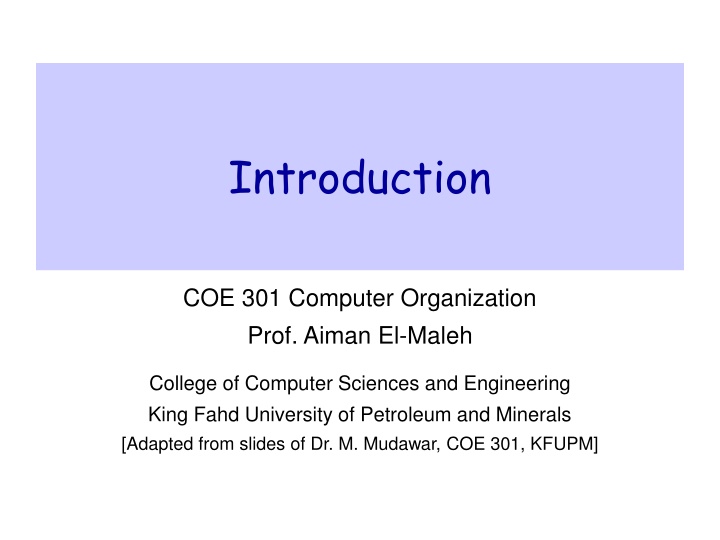
Computer Organization and Languages
Explore the fundamentals of computer organization, from high-level languages to machine code, and learn about the importance of assembly language. Delve into the hierarchy of programming languages and the role of assemblers and compilers in translating code.
Download Presentation

Please find below an Image/Link to download the presentation.
The content on the website is provided AS IS for your information and personal use only. It may not be sold, licensed, or shared on other websites without obtaining consent from the author. If you encounter any issues during the download, it is possible that the publisher has removed the file from their server.
You are allowed to download the files provided on this website for personal or commercial use, subject to the condition that they are used lawfully. All files are the property of their respective owners.
The content on the website is provided AS IS for your information and personal use only. It may not be sold, licensed, or shared on other websites without obtaining consent from the author.
E N D
Presentation Transcript
Introduction COE 301 Computer Organization Prof. Aiman El-Maleh College of Computer Sciences and Engineering King Fahd University of Petroleum and Minerals [Adapted from slides of Dr. M. Mudawar, COE 301, KFUPM]
Next . . . High-Level, Assembly-, and Machine-Languages Components of a Computer System Technology Improvements Programmer s View of a Computer System Introduction COE 301 KFUPM slide 2
Some Important Questions to Ask What is Assembly Language? What is Machine Language? How is Assembly related to a high-level language? Why Learn Assembly Language? What is an Assembler, Linker, and Debugger? Introduction COE 301 KFUPM slide 3
A Hierarchy of Languages Application Programs High-Level Languages Machine independent Machine specific High-Level Language Low-Level Language Assembly Language Machine Language Hardware Introduction COE 301 KFUPM slide 4
Assembly and Machine Language Machine language Native to a processor: executed directly by hardware Instructions consist of binary code: 1s and 0s Assembly language Slightly higher-level language Readability of instructions is better than machine language One-to-one correspondence with machine language instructions Assemblers translate assembly to machine code Compilers translate high-level programs to machine code Either directly, or Indirectly via an assembler Introduction COE 301 KFUPM slide 5
Compiler and Assembler Introduction COE 301 KFUPM slide 6
Instructions and Machine Language Each command of a program is called an instruction (it instructs the computer what to do). Computers only deal with binary data, hence the instructions must be in binary format (0s and 1s) . The set of all instructions (in binary form) makes up the computer's machine language. This is also referred to as the instruction set. Introduction COE 301 KFUPM slide 7
Instruction Fields Machine language instructions usually are made up of several fields. Each field specifies different information for the computer. The major two fields are: Opcode field which stands for operation code and it specifies the particular operation that is to be performed. Each operation has its unique opcode. Operands fields which specify where to get the source and destination operands for the operation specified by the opcode. The source/destination of operands can be a constant, the memory or one of the general-purpose registers. Introduction COE 301 KFUPM slide 8
Translating Languages Program (C Language): A statement in a high-level language is translated typically into several machine-level instructions swap(int v[], int k) { int temp; temp = v[k]; v[k] = v[k+1]; v[k+1] = temp; } Compiler MIPS Assembly Language: MIPS Machine Language: 00051080 00821020 8C620000 8CF20004 ACF20000 AC620004 03E00008 sll $2,$5, 2 add $2,$4,$2 lw $15,0($2) lw $16,4($2) sw $16,0($2) sw $15,4($2) jr $31 Assembler Introduction COE 301 KFUPM slide 9
Advantages of High-Level Languages Program development is faster High-level statements: fewer instructions to code Program maintenance is easier For the same above reasons Programs are portable Contain few machine-dependent details Can be used with little or no modifications on different machines Compiler translates to the target machine language However, Assembly language programs are not portable Introduction COE 301 KFUPM slide 10
Why Learn Assembly Language? Many reasons: Accessibility to system hardware Space and time efficiency Accessibility to system hardware Assembly Language is useful for implementing system software Also useful for small embedded system applications Space and Time efficiency Understanding sources of program inefficiency Tuning program performance Writing compact code Introduction COE 301 KFUPM slide 11
Assembly Language Programming Tools Editor Allows you to create and edit assembly language source files Assembler Converts assembly language programs into object files Object files contain the machine instructions Linker Combines object filescreated by the assembler with link libraries Produces a single executable program Debugger Allows you to trace the execution of a program Allows you to view machine instructions, memory, and registers Introduction COE 301 KFUPM slide 12
Assemble and Link Process Source File Object File Assembler Source File Object File Executable File Assembler Linker Link Source File Object File Libraries Assembler A project may consist of multiple source files Assembler translates each source file separately into an object file Linker links all object files together with link libraries Introduction COE 301 KFUPM slide 13
MARS Assembler and Simulator Tool Introduction COE 301 KFUPM slide 14
MARS Assembler and Simulator Tool Simulates the execution of a MIPS program No direct execution on the underlying Intel processor Editor with color-coded assembly syntax Assembler Converts MIPS assembly language programs into object files Debugger Allows you to trace the execution of a program and set breakpoints Allows you to view machine instructions, edit registers and memory Introduction COE 301 KFUPM slide 15
Next . . . High-Level, Assembly-, and Machine-Languages Components of a Computer System Technology Improvements Programmer s View of a Computer System Introduction COE 301 KFUPM slide 16
Components of a Computer System Processor Computer Datapath Memory Control I/O Devices Memory & Storage Input Control B U S Main Memory Output Processor Disk Storage Datapath Disk Input devices Output devices Network Bus: Interconnects processor to memory and I/O Network: newly added component for communication Introduction COE 301 KFUPM slide 17
Memory Ordered sequence of bytes The sequence number is called the memory address Byte addressable memory Each byte has a unique address Supported by almost all processors Physical address space Determined by the address bus width Pentium has a 32-bit address bus Physical address space = 4GB = 232 bytes Itanium with a 64-bit address bus can support Up to 264 bytes of physical address space Introduction COE 301 KFUPM slide 18
Address Space Address Space is the set of memory locations (bytes) that can be addressed Introduction COE 301 KFUPM slide 19
Address, Data, and Control Bus Address Bus Memory address is put on address bus If memory address = a bits then 2a locations are addressed Data Bus: bi-directional bus Data can be transferred in both directions on the data bus Control Bus Processor Memory Signals control transfer of data address bus a bits 0 1 2 3 Address Register data bus d bits Read request Data Register Write request read write done . . . Done transfer Bus Control 2a 1 Introduction COE 301 KFUPM slide 20
Memory Devices Volatile Memory Devices Data is lost when device is powered off RAM = Random Access Memory DRAM = Dynamic RAM 1-Transistor cell + trench capacitor Dense but slow, must be refreshed Typical choice for main memory SRAM: Static RAM 6-Transistor cell, faster but less dense than DRAM Typical choice for cache memory Non-Volatile Memory Devices Stores information permanently ROM = Read Only Memory Used to store the information required to startup the computer Many types: ROM, EPROM, EEPROM, and FLASH FLASH memory can be erased electrically in blocks Introduction COE 301 KFUPM slide 21
Magnetic Disk Storage A Magnetic disk consists of a collection of platters Provides a number of recording surfaces Read/write head Actuator Recording area Arm provides read/write heads for all surfaces The disk heads are connected together and move in conjunction Track 2 Track 1 Track 0 Arm Platter Direction of rotation Spindle Introduction COE 301 KFUPM slide 22
Magnetic Disk Storage Disk Access Time = Seek Time + Rotation Latency + Transfer Time Read/write head Sector Actuator Recording area Track 2 Seek Time: head movement to the desired track (milliseconds) Track 1 Track 0 Arm Rotation Latency: disk rotation until desired sector arrives under the head Platter Direction of rotation Spindle Transfer Time: to transfer data Introduction COE 301 KFUPM slide 23
Example on Disk Access Time Given a magnetic disk with the following properties Rotation speed = 7200 RPM (rotations per minute) Average seek = 8 ms, Sector = 512 bytes, Track = 200 sectors Calculate Time of one rotation (in milliseconds) Average time to access a block of 32 consecutive sectors Answer Rotations per second Rotation time in milliseconds Average rotational latency Time to transfer 32 sectors Average access time = 8 + 4.17 + 1.33 = 13.5 ms = 7200/60 = 120 RPS = 1000/120 = 8.33 ms = time of half rotation = 4.17 ms = (32/200) * 8.33 = 1.33 ms Introduction COE 301 KFUPM slide 24
Processor-Memory Performance Gap CPU: 55% per year 1000 Moore s Law Performance 100 Processor-Memory Performance Gap: (grows 50% per year) 10 DRAM: 7% per year 1 1985 1981 1982 1983 1984 1986 1987 1988 1989 1990 1991 1992 1993 1994 1995 1996 1997 1999 1998 1980 2000 1980 No cache in microprocessor 1995 Two-level cache on microprocessor Introduction COE 301 KFUPM slide 25
The Need for a Memory Hierarchy Widening speed gap between CPU and main memory Processor operation takes less than 1 ns Main memory requires more than 50 ns to access Each instruction involves at least one memory access One memory access to fetch the instruction A second memory access for load and store instructions Memory bandwidth limits the instruction execution rate Cache memory can help bridge the CPU-memory gap Cache memory is small in size but fast Introduction COE 301 KFUPM slide 26
Typical Memory Hierarchy Registers are at the top of the hierarchy Typical size < 1 KB Access time < 0.5 ns Level 1 Cache (8 64 KB) Microprocessor Access time: 0.5 1 ns Registers L2 Cache (64 KB 8 MB) L1 Cache Access time: 2 10 ns L2 Cache Bigger Faster Main Memory (1 64 GB) Memory Bus Access time: 50 70 ns Memory Disk Storage (> 200 GB) I/O Bus Disk, Tape, etc Access time: milliseconds Introduction COE 301 KFUPM slide 27
Processor Datapath: part of a processor that executes instructions Control: generates control signals for each instruction Next Program Counter Program Counter A L U Instruction Instruction Cache Data Cache Registers Control Introduction COE 301 KFUPM slide 28
Datapath Components Program Counter (PC) Contains address of instruction to be fetched Next Program Counter: computes address of next instruction Instruction Register (IR) Stores the fetched instruction Instruction and Data Caches Small and fast memory containing most recent instructions/data Register File General-purpose registers used for intermediate computations ALU = Arithmetic and Logic Unit Executes arithmetic and logic instructions Buses Used to wire and interconnect the various components Introduction COE 301 KFUPM slide 29
Fetch - Execute Cycle Fetch instruction Compute address of next instruction Infinite Cycle implemented in Hardware Instruction Fetch Generate control signals for instruction Read operands from registers Instruction Decode Compute result value Execute Read or write memory (load/store) Memory Access Writeback Result Writeback result in a register Introduction COE 301 KFUPM slide 30
Next . . . Assembly-, Machine-, and High-Level Languages Components of a Computer System Technology Improvements Programmer s View of a Computer System Introduction COE 301 KFUPM slide 31
Technology Improvements Vacuum tube transistor IC VLSI Processor Transistor count: about 30% to 40% per year Memory DRAM capacity: about 60% per year (4x every 3 yrs) Cost per bit: decreases about 25% per year Disk Capacity: about 60% per year Opportunities for new applications Better organizations and designs Introduction COE 301 KFUPM slide 32
Growth of Capacity per DRAM Chip DRAM capacity quadrupled almost every 3 years 60% increase per year, for 20 years Introduction COE 301 KFUPM slide 33
Processor Performance Slowed down by power and memory latency Almost 10000x improvement between 1978 and 2005 Introduction COE 301 KFUPM slide 34
Next . . . Assembly-, Machine-, and High-Level Languages Components of a Computer System Technology Improvements Programmer s View of a Computer System Introduction COE 301 KFUPM slide 35
Programmers View of a Computer System Application Programs High-Level Language Increased level of abstraction Level 5 Software Assembly Language Level 4 Operating System Level 3 Interface SW & HW Instruction Set Architecture Level 2 Microarchitecture Level 1 Each level hides the details of the level below it Hardware Physical Design Level 0 Introduction COE 301 KFUPM slide 36
Programmers View of a Computer System Application Programs (Level 5) Written in high-level programming languages Such as Java, C++, Pascal, Visual Basic . . . Programs compile into assembly language level (Level 4) Assembly Language (Level 4) Instruction mnemonics (symbols) are used Have one-to-one correspondence to machine language Calls functions written at the operating system level (Level 3) Programs are translated into machine language (Level 2) Introduction COE 301 KFUPM slide 37
Programmers View of a Computer System Operating System (Level 3) Provides services to level 4 and 5 programs Translated to run at the machine instruction level (Level 2) Instruction Set Architecture (Level 2) Interface between software and hardware Specifies how a processor functions Machine instructions, registers, and memory are exposed Machine language is executed by Level 1 (microarchitecture) Introduction COE 301 KFUPM slide 38
Programmers View of a Computer System Microarchitecture (Level 1) Controls the execution of machine instructions (Level 2) Implemented by digital logic Physical Design (Level 0) Implements the microarchitecture at the transistor-level Physical layout of circuits on a chip Introduction COE 301 KFUPM slide 39





